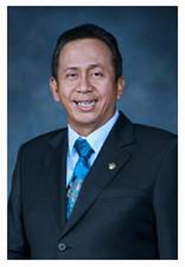
I thank and congratulate all 96 participants from 42 SAIs who participated in the WG18 meeting in July in Bandung, Indonesia. I hope everyone, when not attending sessions, was able to wander through and wonder at the mountains surrounding this famous city. While mountains are stable by nature, it is our mission at WGEA to make stable measurements of the environment and create auditing systems that will stand the test of time.
This forum remains the best approach for working on common issues. People can get together, share experiences, find solutions, and dig deeper. It is this challenge, this excitement, that is not always expressed, but at WGEA we are getting results. We are seeking, findin…
Read More...SAIs Engaging With Stakeholders in Auditing SDGs
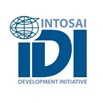 One of the key messages in auditing preparedness of the Sustainable Development Goals (SDGs) under the Knowledge Sharing Committee (KSC) and INTOSAI Development Initiative (IDI) program is how Supreme Auditing Institutions (SAIs) engage with stakeho…
One of the key messages in auditing preparedness of the Sustainable Development Goals (SDGs) under the Knowledge Sharing Committee (KSC) and INTOSAI Development Initiative (IDI) program is how Supreme Auditing Institutions (SAIs) engage with stakeho…
Read about your fellow auditors' work on environmental issues

I thank and congratulate all 96 participants from 42 SAIs who participated in the WG18 meeting in July in Bandung, Indonesia. I hope everyone, when not attending sessions, was able to wander through and wonder at the mountains surrounding this famous city. While mountains are stable by nature, it is our mission at WGEA to make stable measurements of the environment and create auditing systems that will stand the test of time.
This forum remains the best approach for working on common issues. People can get together, share experiences, find solutions, and dig deeper. It is this challenge, this excitement, that is not always expressed, but at WGEA we are getting results. We are seeking, finding, and implementing solutions. This is impressive.
All environments, whether urban or rural, need sustainable management. This requires tools, and tools require inventors; this is what WGEA does. Each of our countries—and the future—needs this commitment, and I feel optimistic that together we can get accurate numbers we need to understand human impacts. From this, we all can participate in predicting future impacts and meeting the vision of sustainable development to leave enough for tomorrow after taking enough for today.
I salute the leadership I see across WGEA and in projects that indicate so many people’s active commitment to global environmental auditing. With your support, WGEA continues to play a crucial role in upholding the value of vibrant and healthy environments and our invisible footprint to successfully measure all other footprints.
Dr. Moermahadi Soerja Djanegara, CPA, CA
Chairman
Audit Board of the Republic of Indonesia
SAIs Engaging With Stakeholders in Auditing SDGs
 One of the key messages in auditing preparedness of the Sustainable Development Goals (SDGs) under the Knowledge Sharing Committee (KSC) and INTOSAI Development Initiative (IDI) program is how Supreme Auditing Institutions (SAIs) engage with stakeholders in auditing SDGs.
One of the key messages in auditing preparedness of the Sustainable Development Goals (SDGs) under the Knowledge Sharing Committee (KSC) and INTOSAI Development Initiative (IDI) program is how Supreme Auditing Institutions (SAIs) engage with stakeholders in auditing SDGs.
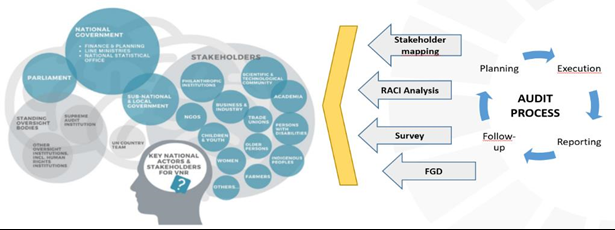
Program focuses on engagement with stakeholders during audits
This notion of stakeholder engagement comes from the way audit teams conduct their work and the nature of the subject matter of SDGs related to stakeholder engagement.
About 73 SAIs and one subnational audit office are participating in a capacity development program on ‘Auditing Sustainable Development Goals.’ They have been working with a new audit approach that will enable a wider involvement of stakeholders in examining participation and making sure no one is left behind in the implementation of the SDGs.
The World Public Sector Report 2018 mentions the articulation of stakeholder engagement. This report addresses mechanisms that support participatory, multi-sectoral, and multi-level problem solving, all of which are needed to achieve long-term integrated approaches. These approaches must involve a wide range of stakeholders, including various levels of government. Adhering to the principle of “leaving no one behind,” as enshrined in the 2030 Agenda for Sustainable Development, also requires engagement with the full range of diverse stakeholders, with a particular focus on marginalized groups and individuals.
Experience from the cooperative performance audit on the preparedness for the implementation of the SDGs has demonstrated the importance of stakeholder engagement when assessing the national systems’ readiness to report on the level of progress towards achieving the SDGs.
To observe this, the program has provided audit teams with techniques and information on how to consider stakeholder engagement in their audits. This was then put into the three audit objectives, which together comprise the adaptation of the 2030 Agenda into a national context, secure the means of implementation, and establish a mechanism on monitoring, follow up, and reporting on the progress towards the implementation of the 2030 Agenda.
The cooperative performance audit encouraged the audit teams to expand their audit methodology, which could answer the need to capture a complete picture of the SDGs in their national context. One audit tool the audit team used was stakeholder mapping, which could identify relevant stakeholders in terms of their role(s), interest, and influence in the arrangement of the SDGs. This tool is combined with the RACI analysis, which enables the team to assign somebody responsible, accountable, consulted, or informed for all activities undertaken in the institutional arrangement of the SDGs.
The audit team also explored audit techniques that can incorporate an increased level of participation by stakeholders, such as an extensive survey and the focus group discussion to observe stakeholders’ perceptions of the SDGs.
As one of the participating SAIs, SAI Saint Lucia conducted a survey during the audit process to determine the public’s awareness of the SDGs.
The audit team noted various observations of the public in terms of its understanding of, involvement in preparation of, interest in, and ownership of the SDGs. SAI Saint Lucia found that the majority of the people surveyed have not been involved in or informed about the 2030 Agenda. Of these surveyed, 62 percent were not aware of the term SDGs.
SAI Saint Lucia’s finding also revealed that, of the 38 percent of people who were aware of the SDGs, 78 percent indicated that they did not have a full understanding of the goals, in that they could not name any of the 17 goals and were not aware of any preparation initiated by their government for the SDGs. This is an indication that the sensitization drive did not fulfill its goal.
The survey also revealed that even though the majority of the public was not aware of or involved in the SDGs, the public is still interested in the SDGs. Of those surveyed, 88 percent indicated that they would attend meetings and workshops aimed at informing them about the goals, and 95 percent indicated their interest in getting more information. Also, 98 percent believe the SDGs will have a positive impact on the citizens of Saint Lucia.
The audit conducted by SAI Saint Lucia indicated that engagement with stakeholders has led to understanding stakeholders as beneficiaries and monitoring agents in SDG implementation that could contribute direct knowledge of how services and programs work for them in practice.
Another lesson learned from the way the audit team explored stakeholder engagement was through SAI Bhutan’s and SAI Indonesia’s use of stakeholder mapping and RACI analysis to understand the institutional arrangements and the participatory process of monitoring and evaluating the SDGs.
Using these methods, SAI Bhutan identified the roles and interests of the private sector, civil society organizations (CSOs), and marginalized groups in creating ownership for the implementation of the SDGs. SAI Bhutan found no separate consultation and review in preparation to implement the SDGs, and no interface for the private sector, CSOs, and marginalized groups to engage with and account for their contributions towards nation-building and the
SDGs. Consequently, the government and the Gross National Happiness Committee (GNHC) have not engaged the citizens and various stakeholders in promulgating the principles of their SDGs and their role in the national planning process.
The interviews SAI Bhutan did with the private sector and CSOs indicated that relevant government agencies had no formal awareness about the SDGs. Apart from the presentations and discussions, no other channels of communication—including radio, TV, newspapers, and leaflets—were used. GNHC stated that these channels were not feasible due to the lack of an identified agency to lead communication initiatives.
SAI Indonesia conducted an extensive focus group discussion with a university that serves as the SDGs Research Center in Indonesia, in order to obtain a comprehensive understanding of academia’s perspective of the SDG platform in Indonesia. SAI Indonesia then used this discussion as relevant information in audit planning and execution. Based on its analysis, the team developed further analysis on how to best formulate the institution to promote multistakeholder engagement.
SAI Indonesia also interviewed key actors regarding the process of raising awareness, using stakeholder mapping and RACI analysis of related documents, such as communication strategies, minutes of meetings, and the SDGs Secretariat’s working papers. The audit team found that the participation of the marginal community in Indonesia should be enhanced in raising awareness, while the operational details of communication strategy also need to be developed to clarify the guidance.
From the experiences shown above, SAIs may have to look beyond their traditional mechanisms when collecting evidence by consulting with a wider set of stakeholders throughout the audit process. This will allow SAIs to examine participation in SDG implementation and ensure no one is left behind.
Stakeholders expect more from SDG audits to capture their involvement in the implementation of the SDGs. By including stakeholders’ needs and expectations, audits would generate value for citizens and make the work of SAIs more relevant.
For more information, please contact Mr. Yudi Ramdan Budiman, Manager Capacity Development, INTOSAI Development Initiative, at yudi.budiman@idi.no.
About 100 participants from 42 SAIs gathered on July 16 through 19, 2018, at the Trans Luxury Hotel in Bandung, Indonesia, for the 18th Assembly Meeting of INTOSAI WGEA.
Starting with an environmental excursion on July 16, participants were presented with the Greening Cities Initiatives of the City of Bandung, complete with a tour around the city to see the actual initiatives come to life.
On July 17, the Chairman of SAI Indonesia and INTOSAI WGEA formally opened the 18th Assembly Meeting. The 3-day meeting consisted of plenary sessions and parallel sessions on the 12 projects in the 2017-2019 Work Plan.
The themes of the plenary sessions were How to Improve the Quality of Urban Environment, Sustainable Land Management, and Environmental Audit and Society. Guest speakers included Indonesian city mayors, ministry officials, and the Auditor General of SAI Australia.
SAI Indonesia also hosted an official dinner for participants on July 18 and a farewell reception on the 19th after the close of the meeting.
The INTOSAI WGEA community plans to meet again in August 2019 in Thailand, while the Steering Committee members held their annual meeting in October 2018 in the Czech Republic.
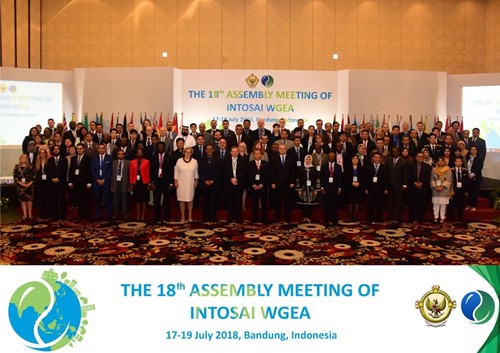
Participants in the 18th Assembly Meeting of INTOSAI WGEA from July 16 to 19, 2018, in Bandung, Indonesia
2018
November 12-December 16
EUROSAI WGEA Massive Online Open Course (MOOC) on “Auditing Water Issues” Online, see story on Regional News
November 26-December 8
Sixth International Training Programme on “Introduction to Environmental Auditing” Jaipur, India
2019
January 21-25
International Workshop on “Audit of Waste Management” Jaipur, India
Early August
INTOSAI WGEA Assembly Meeting Thailand, details TBA
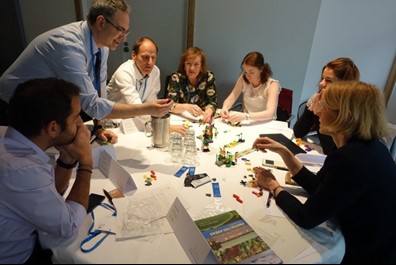 The National Audit Office of Finland hosted the EUROSAI WGEA Spring Session on Environmental Governance on April 26 and 27, 2018, in Helsinki, Finland.
The National Audit Office of Finland hosted the EUROSAI WGEA Spring Session on Environmental Governance on April 26 and 27, 2018, in Helsinki, Finland.
Almost 60 participants from 27 SAIs and other institutions attended. Keynote addresses were complemented by presentations from SAIs, and various group exercises inspired participants to discuss how to contribute to the advancement of good governance through environmental audits.
Principles of good governance can serve as valuable audit criteria. After gaining a comprehensive overview on the concept and evolution of environmental governance, participants reflected on the meaning and auditability of the following seven main principles: externalities, decoupling, polluter-pays principle, precautionary principle, best available technology, environmental liability, and resilience.
In the sustainable development section of the seminar, representatives of the Finnish Government introduced sustainable development policy mechanisms, illustrating how to achieve success with a consistent focus on sustainable development coupled with strong governance and communication systems, monitoring, and evaluation. SAI participants then reflected on the sustainable development governance systems in their respective countries.
Participants also explored public interest and stakeholder engagement using a format not typically used in EUROSAI WGEA seminars: the debate. Representatives from the SAIs of Albania, Austria, Bulgaria, and Estonia debated whether involving the public in the decision-making process results in an outcome that is beneficial for the environment.
The main arguments, both in favor and against, emerged from this spirited undertaking in which the audience also actively contributed. Furthermore, interaction and engagement were also explored in the context of the work of SAIs. The use of participatory audit and stakeholder engagement methods as tools for increasing the use and impact of audit reports were introduced and dissected during practical exercises.
See the report of the Spring Seminar for more details and useful references:
https://www.eurosaiwgea.org/meetings/Pages/Spring- Session-on-Environmental-Governance.aspx
The EUROSAI WGEA Massive Open Online Course (MOOC) “Auditing Water Issues” will run from November 12 to December 16, 2018. The MOOC is accessible online and free of charge for all.
Register at https://www.ut.ee/en/currentstudents/moocs.
The course was prepared by several members of EUROSAI WGEA and is based on International Standards of Supreme Audit Institutions (ISSAIs) and the audit practices of SAIs from the EUROSAI region. Practical examples are consequently Europe-centered, but the course can also be useful for students from other regions.
Students who complete the course will receive a certificate from the University of Tartu and will:
Kindly contact Ms. Kaire Kesküla at kaire.keskula@riigikontroll.ee for more information.
The capacity and capability to conduct environmental audits in Australia, New Zealand, and the Pacific continues to grow. This growth is helping to improve environmental outcomes, but the region needs support to maintain momentum.
In May 2018, the Australasian Council of Auditors-General/Pacific Association of Supreme Audit Institutions (ACAG/PASAI) Regional Working Group on Environmental Auditing (RWGEA) met in Brisbane, Australia, for its 10th Meeting.
The program and discussion at the meeting focused on
Attendees included 24 participants from 13 audit offices and representatives from ACAG, PASAI, and the INTOSAI WGEA secretariat.
Participants in the meeting heard from guest speakers on the topics of Sustainable Development Goals (SDGs) and protecting the marine environment. They also received an update on progress with the PASAI INTOSAI Development Initiative (IDI) cooperative audit on SDG implementation that is currently under way in the region.
The meeting also discussed data analytics, a growing area of activity for offices. Data analytics has great potential for environmental audits, but there are often issues with data availability and reliability and the long-term nature of some environmental outcomes. There is a need to be strategic to ensure that data analysis adds value to an audit and to link the data with the environmental context.
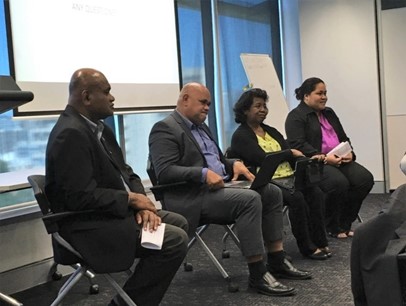
Next Steps for PASAI RWGEA
Environmental auditing is well established in the Australian and New Zealand audit offices but less so in Pacific Island audit offices. All offices involved in environmental auditing continue to face similar issues and challenges, including :
These issues are pressing in many Pacific Island offices, which also face capability and capacity issues. Performance auditing remains relatively new for many Pacific Island members.
That said, there is a substantial appetite for environmental audits in PASAI, and Pacific offices are keen to take up the challenge.
PASAI members have asked the RWGEA, ACAG, and PASAI to develop an environmental auditing training program for the region to build capacity in this area. The program would be specific to the identified needs of Pacific Island audit offices, based on a needs analysis by PASAI, and relevant to the Pacific context. The program will draw on WGEA guidance and training resources, such as the online environmental training massive open online courses (MOOCs). It could also involve one-on-one support through PASAI’s twinning program.
Building on a suggestion from the 2016 RWGEA meeting, PASAI and ACAG are working on a mentoring program that was to be considered at the 2018 PASAI congress in August 2018.
You can see the full communiqué from the meeting on PASAI’s website. For more information please contact
jonathan.keate@oag.govt.nz.
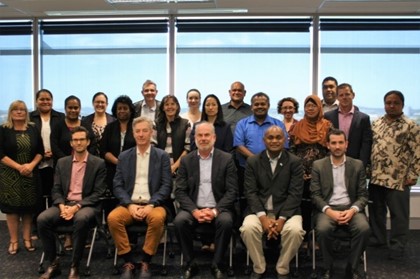
The Special Technical Commission on the Environment (COMTEMA) of the Organization of Latin American and Caribbean Supreme Audit Institutions was created in 1998 with the mission of contributing to the development of environmental audits by its member audit institutions and promoting their integration.
The organization includes 19 Supreme Audit Institutions (SAIs) from Latin America and the Caribbean.
SAI Brazil is presiding over the Commission from 2018 to 2020. COMTEMA’s mandate is to focus on establishing partnerships, enhancing the Commission’s communication, finding new sources of funding, building capacity, and conducting coordinated audits.
COMTEMA is known for recently using the model for coordinated audits. In this model, participant SAIs follow standardized methods and tools to gather and analyze data. In addition to national reports, SAIs produce an Executive Summary that consolidates the results from each country’s audits, thereby providing a regional panorama on the theme.
Recent examples of COMTEMA’s coordinated audits include an audit on protected areas, which presented the Indimapa assessment tool for management and implementation of these areas, and one on Sustainable Development Goals (SDGs). Other topics of interest include environmental liabilities, sustainable public procurement, hydric resources, and climate changes.
COMTEMA is planning a new coordinated audit on protected areas that will include a coordinated followup to the previous review and aggregate new audit questions, such as how the protected areas contribute to the achievement of SDGs 14 and 15 (Life Below Water and Life On Land, respectively).
 Brazil : Coordinated Audit on SDGs in Latin America
Brazil : Coordinated Audit on SDGs in Latin AmericaThe Federal Court of Accounts of Brazil led a coordinated audit to evaluate the preparedness of Latin American governments to implement the 2030 Agenda for Sustainable Development.
Other participating SAIs from the Organization of Latin American and Caribbean Supreme Audit Institutions included Argentina, Chile, Costa Rica, Ecuador, Guatemala, Mexico, Paraguay, Peru, the Dominican Republic, Venezuela, and the audit institution of Buenos Aires Province.
The audit concluded that the 2030 Agenda is taking shape in Latin America. However, while the audit found that national governments are mobilizing in an effort to implement the Agenda’s Sustainable Development Goals (SDGs), they also face challenges.
The major findings of the audit were :
The audit recommended that countries :
For more information, please visit www.tcu.gov.br/sdg or contact Juunius Marques Arifa at juuniusma@tcu.gov.br.
 Ecuador : Audit of License Awarded for Oil Exploitation in Yasuni National Park
Ecuador : Audit of License Awarded for Oil Exploitation in Yasuni National ParkYasuní National Park, located in the heart of the Amazon tropical forest, is the largest protected area in Ecuador, with an area of more than 1 million hectares. The park protects an impressive amount of biodiversity, including more than 2,000 species of trees, 598 species of birds, 121 species of reptiles, and 150 species of amphibians, as well as indigenous people living in voluntary isolation.
The area is also rich in oil deposits, posing a conflict between environmental protection and economic growth. On October 22, 2013, the National Assembly declared the exploration and exploitation of two oil fields located in the park to be of “national interest,” and on May 22, 2014, the Ministry of Environment issued an environmental license allowing the development and production of the Tiputini and Tambococha oil fields.
However, the Assembly considered care of the environment an important part of the exploration activity and, therefore, extractive activities were located near the park with the aim of reducing their environmental impact.
In 2017, the Office of the Comptroller General of Ecuador completed a compliance audit of the environmental license. Officials conducted both document review and technical inspections to confirm that facilities were properly located, drilling platforms were environmentally managed, and sensitive areas were protected.
The audit also examined forest canopy bridges constructed to permit monkeys and birds to transit roads, environmental management of preexisting environmental liabilities, treatment of liquid discharges, reinjection of drilling muds in wells, and the presence of a biotic monitoring station.
As a result of the audit, the Supreme Audit Institution of Ecuador provided compulsory recommendations to the Ministry of the Environment and the licensee, PETROAMAZONAS EP, related to the construction of the biotic monitoring station, river transportation of hazardous waste, environmental annual reports, and a better response to National Environmental Authority inspections.
 Estonia : Energy Efficiency of Public Sector Buildings
Estonia : Energy Efficiency of Public Sector BuildingsThe National Audit Office of Estonia examined how the government is managing to comply with European Union (EU) requirements to (1) renovate 3 percent of the total floor area of buildings owned and occupied by the national government to meet minimum energy performance requirements; (2) transition to nearly zero-energy buildings; and (3) fund energy efficiency renovations sponsored by the national and local governments.
The audit determined that the energy efficiency of buildings owned and occupied by the public sector should be improved. Many public sector buildings in Estonia are not energy efficient or their efficiency is unknown because they have not been assessed or relevant documentation does not exist.
The National Audit Office also determined that the government is unlikely to meet energy efficiency targets set by the EU. The audit concluded that the government needs to pay more attention to improving the energy efficiency of public sector buildings in its budgeting process and when developing and managing public property.
The National Audit Office conducted this review as part of the larger cooperative effort initiated and facilitated by the EUROSAI Working Group on Environmental Auditing. The cooperative audit report will be published in the fall of 2018.
For more details, contact Kristiina Visnapuu at Kristiina.Visnapuu@riigikontroll.ee.
 Fiji : Building Environmental Auditing Capacity
Fiji : Building Environmental Auditing CapacityFiji’s Office of the Auditor General receives its authority to conduct environmental audits from the Fiji Environment Management Act of 2005. The Auditor-General is required to complete audits focused on assuring sustainable development by reviewing the work of agencies responsible for managing Fiji’s natural resources.
The Auditor-General has carried out a number of environment-focused performance audits. In addressing an increasing need to integrate environmental issues in the process of planning and development at both the national and international levels, Fiji’s Auditor-General has established an Environmental Audit team that will conduct environmental audits and follow up on recommendations made in past audits. The team is comprised of experienced environmental auditors as well as staff members who are new to this type of auditing.
To build the capacity to carry out environmental audits, staff members at all levels are provided with opportunities to receive training both locally and overseas.
It is anticipated that the continued commitment to developing environmental auditors will help Fiji’s Auditor-General carry out additional environmental audits for the benefit of its stakeholders.
 Indonesia : Audit of Environmental Licensing Process
Indonesia : Audit of Environmental Licensing ProcessIn 2016, the Audit Board of Indonesia (BPK) conducted a performance audit on the effectiveness of the environmental licensing process from 2013 through 2015.
The audit assessed the effectiveness of environmental licensing management to support sustainable development. The audit concluded that the management of environmental licenses by the Ministry of Environment and Forestry and other related institutions was not fully effective.
Key audit findings included the following:
In order to address its audit findings, BPK recommended the Ministry of Environment and Forestry take several steps, including coordinating with relevant ministries, agencies, and work units to finalize the draft SEA regulation, managing environmental licenses, and levying sanctions against polluters.
The full report is available upon request. Please send your request to ksbhumas@bpk.go.id.
 Jordan : Audit Bureau Reviews Preparations for Sustainable Development Goals
Jordan : Audit Bureau Reviews Preparations for Sustainable Development GoalsThe Audit Bureau of Jordan conducted a review in cooperation with the Netherlands Court of Audit and five Arab SAIs—Algeria, Iraq, Morocco, Palestine, and Tunisia—to evaluate the Jordanian government’s preparations for achieving the United Nations’ Sustainable Development Goals (SDGs) by 2030.
The Audit Bureau adopted a seven-step model as a working methodology and completed the review at the end of June 2018.
The seven-step model was developed by the Netherlands Court of Audit and the European Court of Auditors in 2016 to review a government’s preparedness to implement SDGs. Steps 1 through 4 concern the policy framework and steps 5 through 7 relate to the data framework.
Specifically, the steps assess the government’s actions to:
For the review, the Audit Bureau held bilateral and regional meetings to discuss techniques related to the model, to monitor the audit’s progress of the audit, and to identify audit challenges.
The review showed that the Government of Jordan is reasonably prepared to implement its political commitment to implement the SDGs. It has developed the regulatory and institutional framework to achieve this with participation from representatives of all relevant stakeholder groups and has allocated responsibilities at the ministerial level. It has also adopted the necessary strategic plans and associated them with the necessary statistical data. The government is finalizing the national monitoring and control system to track progress toward the SDGs so that information is accessible to all.
However, the government is confronted with multiple challenges in meeting its commitment, the most important of which is the insecurity and political instability in neighboring countries. In addition, Jordan lacks financial resources to implement these goals, especially after it has received a large number of Syrian refugees who have placed a burden on the treasury.
 Kuwait : Audits of Coastal Pollution and Freshwater Supplies
Kuwait : Audits of Coastal Pollution and Freshwater SuppliesThe State Audit Bureau (SAB) Working Group on Environmental Audit recently issued a report on the efficiency and effectiveness of efforts to protect the Kuwaiti coastline and Al-Kuwait Bay against pollution.
The audit bureau found, among other things, that:
SAB also participates in the Cooperative Audit Plan on Water Environmental Protection of the Asian Organization of Supreme Audit Institutions (ASOSAI) Working Group on Environmental Audit. The Working Group submitted a research plan to evaluate the Kuwaiti Ministry of Electricity & Water’s efforts related to freshwater sustainability.
The final report will address several objectives, including:
For further information, please contact Adel Hussain Al-Kout at training@sabq8.org.
 Latvia : Audit Finds Project Management Deficiencies in Dismantlement of Nuclear Research Reactor
Latvia : Audit Finds Project Management Deficiencies in Dismantlement of Nuclear Research ReactorIn the 1960s, the only civilian research reactor in the Baltic States was constructed in Salaspils, Latvia. In 1995, a few years after the collapse of the Soviet Union, the Latvian government decided to shut down the reactor—which was based on a former Soviet design— and to prepare for decommissioning and dismantlement.
The dismantlement of the reactor is time-sensitive because of the radioactive waste it contains. In addition, the government accrues additional costs associated with safe maintenance of the reactor in proportion to any delays in completing the dismantlement.
During the 2017 financial audit of the Ministry of Environmental Protection and Regional Development, the State Audit Office of Latvia (SAO) assessed the plans for dismantling the reactor. The audit found that the Ministry had not updated the dismantlement plan, including whether the reactor should be demolished completely or adapted for other scientific activities. These alternatives differ in cost by a factor of more than three.
The Ministry has taken actions in the dismantlement project that were not planned in a consecutive and coordinated way. For example, the Ministry made procurements for the demolition of the reactor without an up-to-date plan for the dismantlement. Moreover, the project requires additional funding but the funding requested is based on outdated, 15-year-old calculations. These open the Ministry to the risk that the project will require significantly higher funding during implementation than planned.
SAO recommended that the Ministry apply best practices for project management in dismantling the research reactor by providing proper management of all project areas, including project integration, scope, time, costs, quality, human resources, communication, risks, procurement, and stakeholder involvement.
For further information, please contact Mr. Jānis Salenieks at Janis.Salenieks@lrvk.gov.lv.
 Norway : Audit of International Climate and Forest Initiative
Norway : Audit of International Climate and Forest InitiativeIn May 2018, the Office of the Auditor General of Norway (OAGN) published a report on Norway's International Climate and Forest Initiative (NICFI). The audit assessed Norway's efforts to establish an effective means to reduce greenhouse gas emissions from deforestation and forest degradation in developing countries, known as REDD+.
The audit included analyses of the progress and results achieved to date in REDD+ countries supported by NICFI. OAGN found that NICFI support for tropical forest preservation has had uncertain effects and that incentivizing reductions in deforestation and degradation through the use of REDD+ and results-based payments is more difficult than initially assumed. Conflicts of interest and changing political priorities in partner countries have hindered and delayed actions and positive results.
Further, OAGN found that Norwegian authorities have insufficient control of implementation and results. There is inadequate reporting and follow-up on concerns such as indigenous peoples' rights, poverty alleviation, and preservation of natural forests. In general, the lack of a systematic approach to the acquisition and analyses of data about results has weakened the basis for managing and building experience with REDD+.
In addition, the OAGN pointed to instances in which the Ministry of Foreign Affairs and the Ministry of Climate and Environment did not sufficiently prevent or address the risk of fraud. This included instances of inadequate evaluation of partners prior to entering into agreements and inadequate response to partners investigated for potential fraud.
You can find additional details in English at www.riksrevisjonen.no/en/Pages/Homepage.aspx.
For further information, please contact Karine Thorsell Hansen at karine-thorsell.hansen@riksrevisjonen.no.
 Slovenia : Court of Audit to Examine Forest Management
Slovenia : Court of Audit to Examine Forest ManagementThe Republic of Slovenia is one of the most forested countries in Europe, with more than 60 percent of its area covered by forests.
In recent years, bark beetles have caused more damage to Slovenian forests than any other biotic or abiotic threat. Bark beetles are pests that reproduce in the inner bark of trees, especially conifers, killing them. They cause the greatest damage to spruce, which is an important natural and economic resource in Slovenia. It is likely that climate change will contribute to greater bark beetle damage, making forest management and planning critical.
In fall 2018, the Court of Audit of the Republic of Slovenia will issue an environmental performance audit report on the efficiency of the key entities responsible for monitoring and preventing damage caused by bark beetles.
Follow us at @racunskosodisce, where we will publish a summary of the audit report and infographic in English.
For requests or questions, contact Dijana M. Zupanc at Dijana.Mozina-Zupanc@rs-rs.si.
 Tanzania : Audit of Sewage Services in Urban Areas
Tanzania : Audit of Sewage Services in Urban AreasIn April 2018, the Controller and Auditor General of Tanzania presented to the Parliament a performance audit of the provision of sewage services in urban areas. The audit reviewed the performance of the Ministry of Water and Irrigation and the President’s Office⎯Regional Administration and Local Government (PO-RALG).
The provision of on-site sanitation services by PO-RALG through local government authorities is not adequate. The audit found that access to the sewer network is low and has not significantly improved over time; more than 70 percent of urban dwellers lack access to the sewer network.
The analysis also revealed that not all sewage is collected in a timely manner. This has led to overflows from septic tanks, especially from commercial buildings and in highly populated areas. It has also accelerated the illegal discharge of sewage to the environment during the rainy season. In addition, a high percent of generated sewage is not disposed in officially recognized sludge ponds, which are usually connected to a wastewater stabilization pond.
Half of the local government authorities visited lacked waste treatment facilities and therefore disposed of untreated sewage into water bodies such as rivers. This affects the environment and may lead to an increase in sanitation-related diseases.
The audit found that inadequate control or misuse of sewer systems and the absence of coordination between local government authorities and urban water and sewerage service authorities in controlling damage to the sewer network have caused poor performance.
Finally, the PO-RALG does not have key performance indicators for monitoring the provision of on-site sanitation activities. The audit noted further that PORALG’s key performance indicators and plans focused on water-related issues and, to an extent, covered the issues of building on-site sanitation facilities such as toilets in public institutions. However, sewage collection, transportation, and disposal activities were not adequately monitored.
The audit recommended that the PO-RALG ensure that local government authorities :
In addition, the Ministry of Water and Irrigation should ensure that:
For further information, please contact Mr. George C. Haule at ghaule@nao.go.tz or Mr. Frank Mwalupale at ffmwalu@yahoo.com.

The INTOSAI Working Group on Environmental Auditing (WGEA) aims to increase the expertise in environmental auditing and to enhance environmental governance with high-quality contribution and visibility by both members of the Working Group and non–member SAIs. Currently the INTOSAI WGEA consists of 86 member countries.
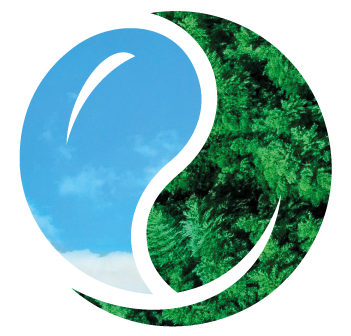
Vivi Niemenmaa - Secretary General
Email: vivi.niemenmaa@vtv.fi
Kati Hirvonen - Project Specialist
Email: kati.hirvonen@vtv.fi
India Roland - International Affairs Planner
Email: india.roland@vtv.fi
Mohamed Ibrahim Jaleel - Environmental Audit Manager
Email: mohamed.jaleel@audit.gov.mv
We collect and process your data on this site to better understand how it is used. We always ask you for consent to do that. You can change your privacy settings here.